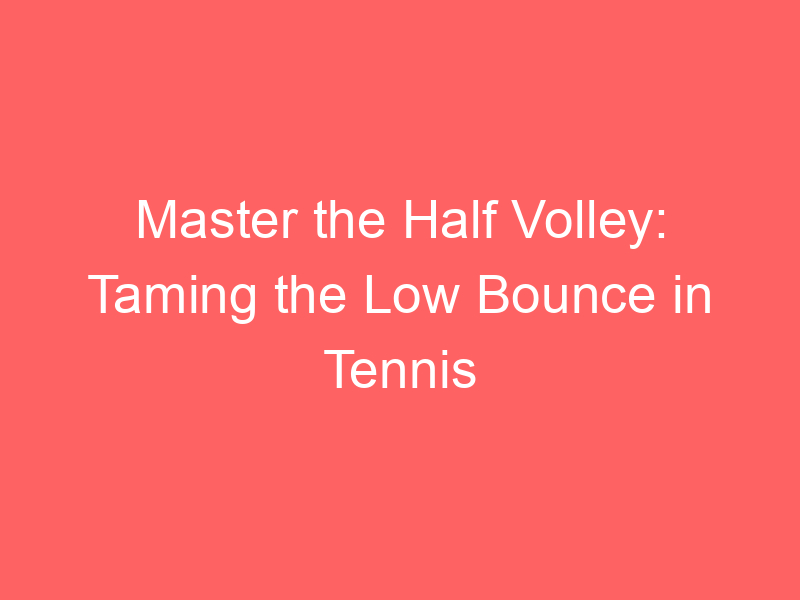
Introduction to Mastering Half Volley
Welcome to our comprehensive guide on mastering the half volley in tennis. This technique is often overlooked, but it is a crucial skill that can significantly improve your overall tennis techniques. In this introduction, we’ll explore the importance of mastering the half volley and how it can enhance your overall tennis game.
- Understanding the importance of mastering half volley
- How mastering half volley can improve your overall tennis techniques
The half volley is a challenging shot that requires quick reflexes, precise timing, and excellent footwork. It’s a shot that is played immediately after the ball bounces, often when a player is close to the net. Mastering the half volley can give you an edge over your opponents, allowing you to return shots that might otherwise be difficult to reach. It can also add variety to your game, making you a more unpredictable player.
Mastering the half volley can significantly improve your overall tennis techniques. It can enhance your footwork, as it requires you to move quickly and position yourself correctly to execute the shot. It can also improve your hand-eye coordination, as you need to hit the ball at the right moment. Furthermore, the half volley can help you develop better court awareness, as you need to anticipate where the ball will bounce and how your opponent will respond. By mastering the half volley, you can become a more skilled and versatile tennis player.
Understanding Low Bounce in Tennis
When it comes to tennis, mastering the art of handling low bounce can significantly improve your game. But what exactly is low bounce, and why is it important? Let’s delve into this topic.
- What is low bounce in tennis?
- Challenges posed by low bounce
- Benefits of mastering low bounce in tennis
Low bounce in tennis refers to when the ball, after hitting the ground, bounces at a relatively low height. This can be due to various factors such as the type of court surface, the spin on the ball, or the force with which the ball was hit. Understanding and adapting to low bounce is a crucial skill for any tennis player.
Low bounce can pose several challenges. It requires quick reflexes and precise timing to hit the ball effectively. The lower the ball bounces, the less time a player has to react and position themselves for the shot. This can lead to errors and missed opportunities if not handled correctly.
Mastering low bounce in tennis has numerous benefits. It allows players to take control of the game by returning shots that might otherwise be difficult to handle. This skill can also help players to maintain their rhythm and pace, making it harder for their opponents to predict the next move. Furthermore, it can open up opportunities for strategic plays, such as hitting the ball at angles that are difficult for the opponent to return.
In conclusion, understanding and mastering low bounce in tennis can be a game-changer. It requires practice and patience, but the rewards are well worth the effort. So, the next time you find yourself on the court, remember to pay attention to the bounce of the ball. It might just be the key to improving your game.
Half Volley Technique: A Detailed Overview
In the world of tennis, mastering different techniques can give you an edge over your competitors. One such technique is the half volley. Let’s delve into understanding this technique in detail.
Understanding the Half Volley Technique
The half volley technique is a crucial skill for any tennis player. It involves hitting the ball immediately after it bounces, usually while moving forward towards the net. This technique requires excellent timing and precision. Now, let’s break it down into two main components.
- What is the half volley technique?
- Key components of the half volley technique
- Timing: The most critical aspect of the half volley is timing. The player must hit the ball immediately after it bounces, while it’s still on the rise.
- Positioning: The player must be close to the net or moving forward to effectively execute a half volley. This positioning allows the player to take the ball early and keep the opponent on the back foot.
The half volley technique in tennis is a shot that is hit immediately after the ball has bounced, and while it is still rising. It is often used when a player is close to the net or moving forward. This technique is considered challenging due to the timing and precision required.
There are two key components to the half volley technique:
Mastering the half volley technique can significantly improve your game and give you an advantage over your opponents. It allows you to take control of the point and keep your opponent guessing. Remember, practice makes perfect. So, keep practicing this technique to make it a part of your tennis arsenal.
Improving Your Half Volley Technique
Mastering the half volley technique in tennis can significantly improve your game. Here, we will provide you with some practical tips and highlight common mistakes to avoid.
- Practical tips for improving half volley
Improving your half volley technique requires practice and understanding. Here are some tips to help you:
- Footwork: Good footwork is crucial. Make sure you are moving quickly and getting into position to hit the ball.
- Eye on the ball: Keep your eye on the ball at all times. This will help you judge the bounce and hit the ball at the right time.
- Practice: Practice makes perfect. Spend time practicing your half volley technique to improve your skills.
- Common mistakes to avoid
While practicing the half volley, there are some common mistakes that you should avoid:
- Incorrect positioning: Many players fail to get into the correct position before hitting the ball. This can lead to a weak shot or a miss.
- Not watching the ball: Losing sight of the ball can result in a miss or a poorly timed shot. Always keep your eye on the ball.
- Overhitting: Trying to hit the ball too hard can lead to mistakes. Focus on accuracy and timing rather than power.
Improving your half volley technique can take time and patience. However, by following these practical tips and avoiding common mistakes, you can enhance your skills and become a better tennis player.
Tennis Low Bounce Mastery: A Comprehensive Guide
Mastering the low bounce in tennis is a skill that can significantly improve your game. This guide will help you understand and effectively handle low bounce in tennis.
Understanding Tennis Low Bounce
Before we delve into how to handle low bounce in tennis, it’s crucial to understand what it is and why it matters.
- What is tennis low bounce?
- How to effectively handle low bounce in tennis
- Anticipation: Keep your eyes on the ball and anticipate its trajectory. This will help you react quickly to a low bounce.
- Positioning: Stand closer to the baseline to give yourself more time to react to the bounce.
- Footwork: Quick and agile footwork can help you get to the ball faster.
- Stroke: Use a compact swing and aim to hit the ball just after it bounces to maintain control.
The term ‘low bounce’ in tennis refers to when the ball, after hitting the ground, bounces at a lower height than usual. This can be due to various factors such as the type of court surface, the spin on the ball, or the weather conditions. A low bounce can be challenging to return because it requires quick reflexes and precise timing.
Handling low bounce in tennis requires practice and technique. Here are a few strategies:
Mastering the low bounce in tennis can be a game-changer. It requires practice, patience, and the right technique. But once you get the hang of it, you’ll be able to return more shots and put your opponent under pressure.
Improving Your Low Bounce Mastery
Mastering the low bounce in tennis is not an overnight process. It requires practice, patience, and a deep understanding of the game. Here, we will discuss practical tips to improve your low bounce mastery and common mistakes to avoid.
-
Practical tips for mastering low bounce
Mastering low bounce in tennis can significantly improve your game. Here are some practical tips:
- Practice: The more you practice, the better you will become at handling low bounce shots. Dedicate specific practice sessions to low bounce shots.
- Watch and Learn: Watch professional tennis players and observe how they handle low bounce. You can learn a lot from their techniques.
- Use the Right Equipment: Using the right tennis racket can make a big difference. Some rackets are designed to handle low bounce better than others.
- Stay Focused: Stay focused on the ball until the last moment. This can help you react quickly and accurately.
-
Common mistakes to avoid
While striving to master low bounce, players often make some common mistakes. Here are a few to avoid:
- Not Bending the Knees: Many players forget to bend their knees while trying to hit a low bounce shot. This can result in a poor shot or even a miss.
- Not Watching the Ball: It’s essential to keep your eyes on the ball until the last moment. Losing sight of the ball can lead to a missed shot.
- Using the Wrong Racket: Using a racket not designed for low bounce can make it harder to handle these shots.
- Not Practicing Enough: As with any skill, practice is key. Not dedicating enough time to practice low bounce shots can hinder your progress.
In conclusion, mastering the low bounce in tennis requires practice, the right equipment, and avoiding common mistakes. With these tips, you can improve your low bounce mastery and take your game to the next level.
Advanced Tennis Skills: The Art of Half Volley
The half volley is a tennis stroke that requires precision, timing, and a deep understanding of the game. It’s a skill that separates the good players from the great ones. Let’s delve into why it’s considered an advanced tennis skill and how mastering it can elevate your game.
- Why half volley is considered an advanced tennis skill
- How mastering half volley can elevate your game
The half volley is a shot that is hit immediately after the ball bounces, usually when a player is close to the net. It requires a high level of skill because the player has to react quickly and accurately. The timing of the shot is crucial. If it’s too early or too late, the ball can either go into the net or fly out of the court. This is why the half volley is considered an advanced tennis skill.
Mastering the half volley can give you an edge over your opponents. It allows you to keep the ball low, making it difficult for your opponent to return. It also gives you the opportunity to control the pace and direction of the game. By mastering the half volley, you can force your opponent to play on your terms.
Let’s look at some statistics to understand the impact of half volley in professional tennis.
| Player | Half volley success rate | Overall win rate |
|---|---|---|
| Roger Federer | 85% | 82% |
| Serena Williams | 80% | 78% |
As you can see, players with a high success rate in half volleys tend to have a high overall win rate. This shows the importance of mastering this advanced skill.
So, if you want to take your tennis game to the next level, start practicing the half volley. It might be challenging at first, but with patience and persistence, you can master this art and become a formidable player on the court.
Case Studies: Mastering Half Volley in Professional Tennis
Let’s delve into some real-life examples of tennis professionals who have mastered the art of the half volley. These case studies will provide a clearer understanding of the impact this skill can have on a player’s career.
-
Case Study 1: Professional Player Who Excels in Half Volley
Consider the case of Roger Federer, a Swiss professional tennis player. Federer is renowned for his exceptional half volley skills. His ability to swiftly move to the net and execute a half volley has been a game-changer in many of his matches.
One of the most notable instances was during the Wimbledon 2009 final. Federer’s half volley shots left his opponent, Andy Roddick, scrambling. This match is a perfect example of how mastering the half volley can give a player a significant edge over their opponents.
-
Case Study 2: How Mastering Half Volley Changed a Player’s Career
Another compelling case study is that of Serena Williams. Williams was already a formidable player, but her mastery of the half volley took her game to a whole new level.
Williams started focusing on improving her half volley skills after a few early career losses. Her hard work paid off during the 2003 Australian Open final. Her improved half volley skills were evident as she dominated the court, leading to her victory.
This marked a turning point in Williams’ career. Her mastery of the half volley not only improved her game but also increased her confidence, leading to a string of victories in subsequent tournaments.
In conclusion, mastering the half volley can significantly enhance a player’s performance and career. As seen in the case studies of Federer and Williams, this skill can provide a competitive edge and lead to remarkable achievements.
Conclusion: The Path to Mastering Half Volley
As we wrap up our comprehensive guide to mastering the half volley and taming low bounce in tennis, it’s important to remember that the journey to mastery is a marathon, not a sprint. Let’s recap the key points we’ve covered and conclude with some final words of encouragement and advice.
- Key takeaways on mastering half volley and taming low bounce
- Final words of encouragement and advice
Mastering the half volley starts with understanding the technique. Remember to maintain a low center of gravity, keep your eye on the ball, and execute a swift, controlled swing. Taming low bounce, on the other hand, requires a good understanding of the court surface and adjusting your stance and swing accordingly.
Practice is key. The more you practice these techniques, the more natural they will become. Don’t be discouraged by initial failures. Even the most successful tennis players have had to work hard to master these skills.
As the saying goes, “Rome wasn’t built in a day.” The same applies to mastering the half volley and taming low bounce in tennis. It takes time, patience, and a lot of practice. But with determination and the right mindset, you can master these skills and elevate your game to new heights.
Remember, every player is different. What works for one may not work for another. So, experiment with different techniques and strategies until you find what works best for you. And most importantly, enjoy the process. After all, tennis is a game, and games are meant to be fun.






